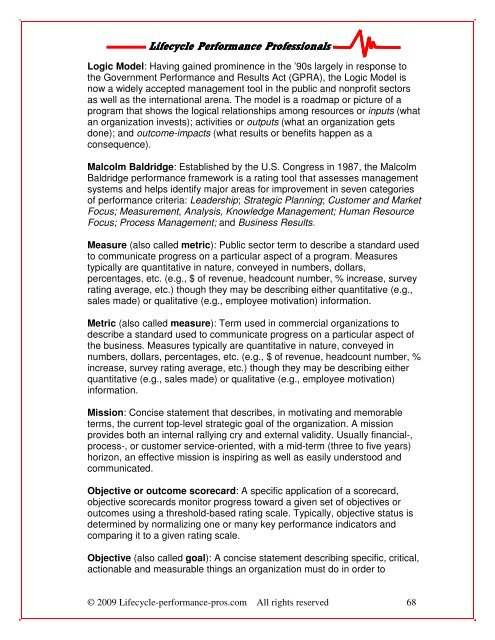Download the Performance Management Fundamentals Guide
Download the Performance Management Fundamentals Guide
Download the Performance Management Fundamentals Guide
You also want an ePaper? Increase the reach of your titles
YUMPU automatically turns print PDFs into web optimized ePapers that Google loves.
Lifecycle Lifecycle <strong>Performance</strong> <strong>Performance</strong> Professionals<br />
Professionals<br />
Logic Model: Having gained prominence in <strong>the</strong> ’90s largely in response to<br />
<strong>the</strong> Government <strong>Performance</strong> and Results Act (GPRA), <strong>the</strong> Logic Model is<br />
now a widely accepted management tool in <strong>the</strong> public and nonprofit sectors<br />
as well as <strong>the</strong> international arena. The model is a roadmap or picture of a<br />
program that shows <strong>the</strong> logical relationships among resources or inputs (what<br />
an organization invests); activities or outputs (what an organization gets<br />
done); and outcome-impacts (what results or benefits happen as a<br />
consequence).<br />
Malcolm Baldridge: Established by <strong>the</strong> U.S. Congress in 1987, <strong>the</strong> Malcolm<br />
Baldridge performance framework is a rating tool that assesses management<br />
systems and helps identify major areas for improvement in seven categories<br />
of performance criteria: Leadership; Strategic Planning; Customer and Market<br />
Focus; Measurement, Analysis, Knowledge <strong>Management</strong>; Human Resource<br />
Focus; Process <strong>Management</strong>; and Business Results.<br />
Measure (also called metric): Public sector term to describe a standard used<br />
to communicate progress on a particular aspect of a program. Measures<br />
typically are quantitative in nature, conveyed in numbers, dollars,<br />
percentages, etc. (e.g., $ of revenue, headcount number, % increase, survey<br />
rating average, etc.) though <strong>the</strong>y may be describing ei<strong>the</strong>r quantitative (e.g.,<br />
sales made) or qualitative (e.g., employee motivation) information.<br />
Metric (also called measure): Term used in commercial organizations to<br />
describe a standard used to communicate progress on a particular aspect of<br />
<strong>the</strong> business. Measures typically are quantitative in nature, conveyed in<br />
numbers, dollars, percentages, etc. (e.g., $ of revenue, headcount number, %<br />
increase, survey rating average, etc.) though <strong>the</strong>y may be describing ei<strong>the</strong>r<br />
quantitative (e.g., sales made) or qualitative (e.g., employee motivation)<br />
information.<br />
Mission: Concise statement that describes, in motivating and memorable<br />
terms, <strong>the</strong> current top-level strategic goal of <strong>the</strong> organization. A mission<br />
provides both an internal rallying cry and external validity. Usually financial-,<br />
process-, or customer service-oriented, with a mid-term (three to five years)<br />
horizon, an effective mission is inspiring as well as easily understood and<br />
communicated.<br />
Objective or outcome scorecard: A specific application of a scorecard,<br />
objective scorecards monitor progress toward a given set of objectives or<br />
outcomes using a threshold-based rating scale. Typically, objective status is<br />
determined by normalizing one or many key performance indicators and<br />
comparing it to a given rating scale.<br />
Objective (also called goal): A concise statement describing specific, critical,<br />
actionable and measurable things an organization must do in order to<br />
© 2009 Lifecycle-performance-pros.com All rights reserved 68










